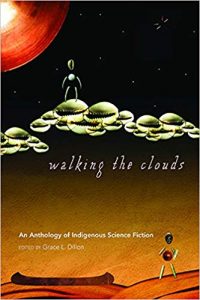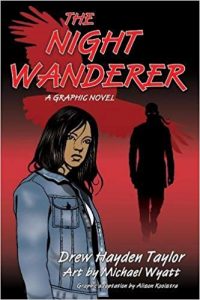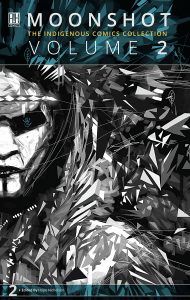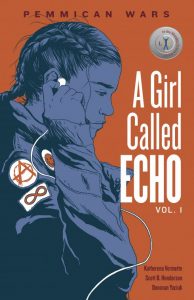This month’s Indigenous display features works on Indigenous futurisms. This genre, explored through a variety of mediums including literature, art, film, and music, expresses Indigenous identity by exploring possible or potential futures for Indigenous peoples. Though many works of Indigenous futurisms are set in the future – where elements of science-fiction such as space, apocalyptic narratives, and alternate reality are often present – stories from this genre can also span the past and present; they are narratives that place Indigenous voices from across time and space into our present consciousness.
 Walking the Clouds: An Anthology of Indigenous Science Fiction edited by Grade Dillon
Walking the Clouds: An Anthology of Indigenous Science Fiction edited by Grade Dillon
The first anthology of Indigenous science fiction, Walking the Clouds helped define the genre of Indigenous futurisms by identifying science fiction as a platform through which Indigenous writers can “renew, recover, and extend First Nation voices and traditions”. Dillon suggests that through Indigenous futurism, writers can confront contemporary issues and explore them on an alternative and empowering world stage, changing how both Indigenous writers and the science fiction genre as a whole are traditionally perceived. Contributions are divided into six sections; native slipstream (time travel, alternate realities, alternative histories), contact, Indigenous scientific literacies and environmental sustainability (understanding sustainability as a rightful science), native apocalypse, revolutions, future reconstruction of sovereignties, and “Biskabiiyang” or “Returning to Ourselves” (how Indigenous peoples are personally affected and their process of recognition, healing and resurgence).
 Future Home of the Living God by Louise Erdrich
Future Home of the Living God by Louise Erdrich
Set in the near-future, Future Home of the Living God outlines the beginning of an apocalypse where evolution has not only ceased, but is actively reversing. Cedar Hawk Songmaker, the novel’s heroine, is faced with a dilemma; adopted as an infant from an Anishinaabe nation in Minnesota, Cedar is now four months pregnant and longs to know the genetic history of her biological parents. As Cedar begins her journey home, the government declares that all pregnant women must turn themselves in for the good of future mankind – or they will be hunted down. Cedar conveys her story through letters written to her future child, using quick wit and dry humour to deliver a captivating and unsettling tale.
 The Night Wanderer: A Native Gothic Novel by Drew Hayden Taylor
The Night Wanderer: A Native Gothic Novel by Drew Hayden Taylor
For fans of vampire stories, The Night Wanderer is a thrilling sci-fi horror story set on an Anishinaabe reserve on Otter Lake. When Tiffany Hunter’s mother abandons their family, her father rents out a spare room to a strange man named Pierre L’Errant. Tiffany soon learns that her roommate’s affinity for darkness and sleeping aren’t quirks, but survival tactics; Pierre is a vampire, and has returned from France to his boyhood home in Otter Lake to conduct an unspeakable mission. While an excellent sci-fi tale in its own right, The Night Wanderer is also a coming-of-age story, in which Tiffany must learn to address relationships with her family, boyfriend, and identity. This novel is adapted by Taylor from his own 1992 play, A Contemporary Gothic Indian Vampire Story.
 Moonshot: The Indigenous Comics Collection, Volume 2 edited by Hope Nicholson
Moonshot: The Indigenous Comics Collection, Volume 2 edited by Hope Nicholson
Following up on the success of Moonshot, Volume 1, Volume 2 offers a collection of Indigenous comics focused on what author Michael Sheyahshe describes as “Indigenous continuance” – focusing on Indigenous peoples and cultures as they exist in the present. In its objective to represent Indigenous peoples “in the now”, Moonshot, Volume 2 brings together a collection of stories that transcend time and space, ranging in genre from historical to sci-fi to other-worldly and representing elements of the past, future, and everything in-between. Among the 14 comics included are Jeffrey Veregge’s Journeys, blending futuristic intergalactic travel with the present values of the Suquamish community, Steve Keewatin Sanderson’s Where We Left Off, a post-apocalyptic narrative based in Plains Cree roots, and Michael Sheyahshe’s Do Wild Turkeys Dream of Drums, a modernized version of the Caddo “Turkey Dance” tradition. Each comic is accompanied by a background paragraph explaining the story’s origins and inspiration, and readers will appreciate Moonshot‘s engaging mix of narratives and artistic styles.
 A Girl Called Echo, Volume 1: Pemmican Wars by Katherena Vermette
A Girl Called Echo, Volume 1: Pemmican Wars by Katherena Vermette
In the first graphic novel of the series A Girl Called Echo, Pemmican Wars tells the story of Echo Desjardins, a lonely young Métis teenager who finds herself unable to cope with life at her new home and school. Overwhelmed by her surroundings, Echo frequently resorts to closing her eyes to block out the world around her. One day, Echo is surprised to open her eyes and find herself transported to the Souris River in 1814, at the onset of the Pemmican Wars. Armed with the gift of time travel, Echo crosses back and forth between the past and present, learning about her ancestral history both in school and on the front lines of the war. Using time travel, Echo discovers that she is able to reconcile past narratives of Métis history with her own personal truths to create a new and powerful identity. A Girl Called Echo relies almost exclusively on illustration, encouraging readers to immerse themselves in the images before them. The book also includes a timeline of the events surrounding the Pemmican Wars.
To explore more books on Indigenous futurisms, be sure to visit the Indigenous display on the ground floor of OISE Library.
